Ukraine's Resources
Quick & dirty overview. One hears many things, I just want to present some research results here.
Recently, some Western leaders said Ukraine has some 12 trillion USD in mineral riches… or something along these lines. While I am always sceptical when I hear such numbers, it got me interested to do a quick research. I will present you some maps I found and write a few words about Ukraine’s basic geology. The objective is to give you a quick overview.
While I have my opinions about the current conflict raging in the Ukraine and am pretty deep into the matter, I won’t talk about all the geopolitical details here. Also, I take the Ukraine as of 2014, since this the disputed geographical area. If Russia wins, they could take over all of Ukraine and if the West wins, they want to have it all as well. What is more likely? Decide that by yourself. I also use Russian geographical names, simply because I am used to them.
With the information I give you, you might better understand how important the country may be, especially for Europe’s supply with resources.
Ukraine’s Geology - the very basics
The most important structure in Ukraine is the Ukrainian shield, stretching from north to southeast through the centre of the country. A shield in geology is an area where old, stable continental crust (craton) crops out at the surface. While there is no specification which rocks do typically occur in a craton, you can generally expect all sorts of metamorphic or meta-sedimentary rocks (often in greenstone belts) and various granitic rocks and the minerals associated with these. Sometimes, younger sediments lie on top of the older stuff, in this case, we geos call this a platform.
Within this stable old crust, tectonic forces still can create basins in which material gets deposited. In the case of Ukraine, the most important one is the Donetsk basin (Donbas) with its rich coal and salt deposits.
This map summarizes that the geological structures:
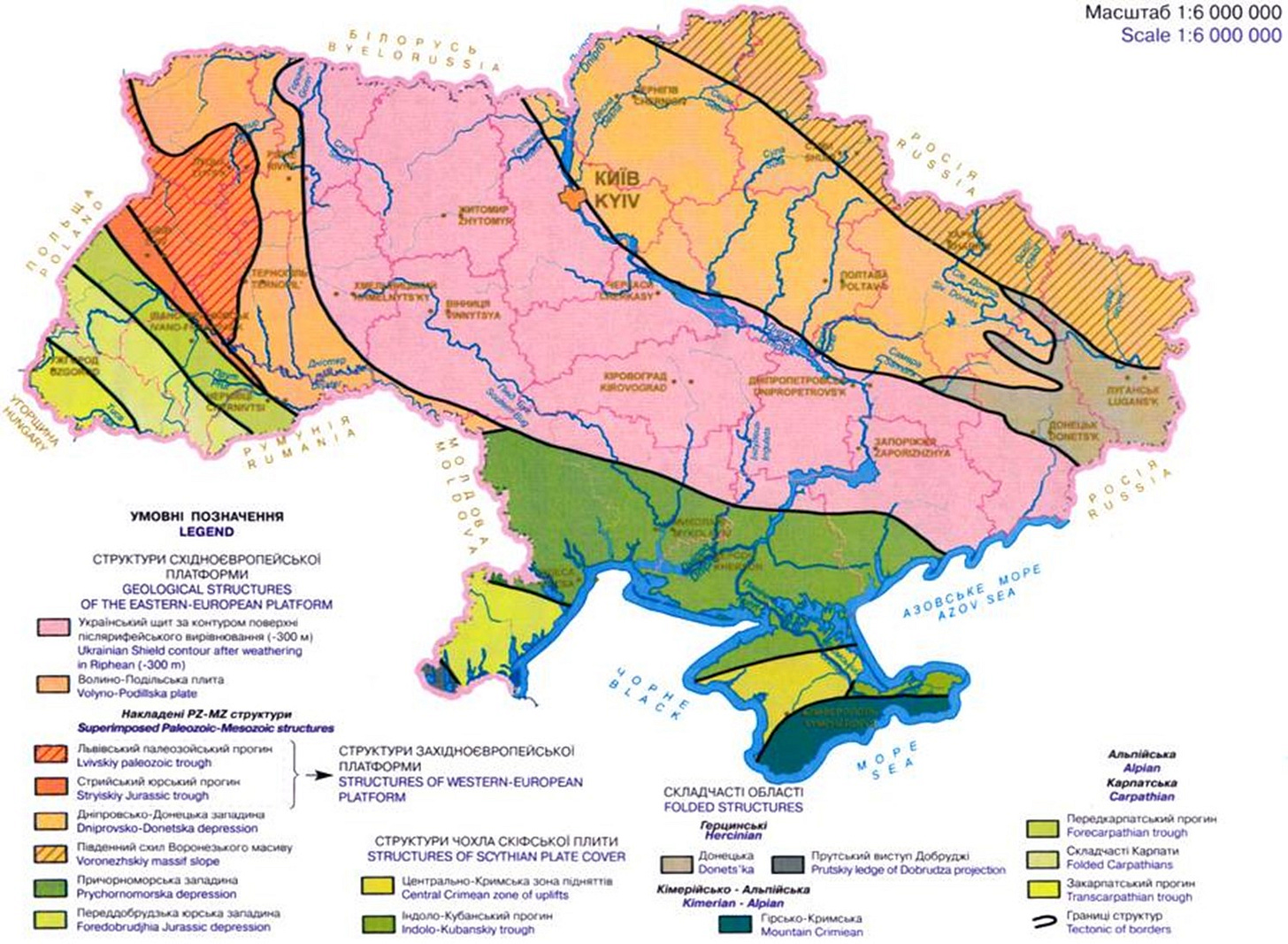
The pinkish area is the shield, the yellowish-grey one is the Donbas. To the south and east of the shield, we find mostly younger sedimentary rocks, generally uninteresting for metal deposits. That also includes Crimea. To the north, sediments overlie the older crust. That’s it in a nutshell.
Mineral deposits
Commodities that are important in Ukraine are mostly iron, coal, manganese & gas. These are the big things, and especially the Donbas, is well known for its rich and high-quality coal deposits. In central Ukraine, around Krivoy Rog, big iron and manganese mines exist. In terms of iron, these are the biggest operations in Europe. The close proximity of coal and iron makes the area very interesting for steel production and since a certain battle took place at a large steel mill, we are all aware of Ukraine’s steel production: Azovstal is located in between the coal and iron/manganese deposits. In terms of manganese (a metal that enhances steel quality), Ukraine has the world’s largest reserves, followed closely by South Africa and Brazil.

Coal
The coal fields of the Donbas are the reason why there is so much population & industry: Before coal was discovered there in 1721 and exploited since the late 19th century, the area was only sparsely populated. Now, it is the major industrial area and was the most important coal basin in the Soviet Union, albeit not the only one.
The Donbas in geological terms is a rift basin. The deepest coal seams are about 2000 m deep and the quality of the coal increases with depth, spanning from lignite near the surface to anthracite in deeper levels. In short: All the coal you need.
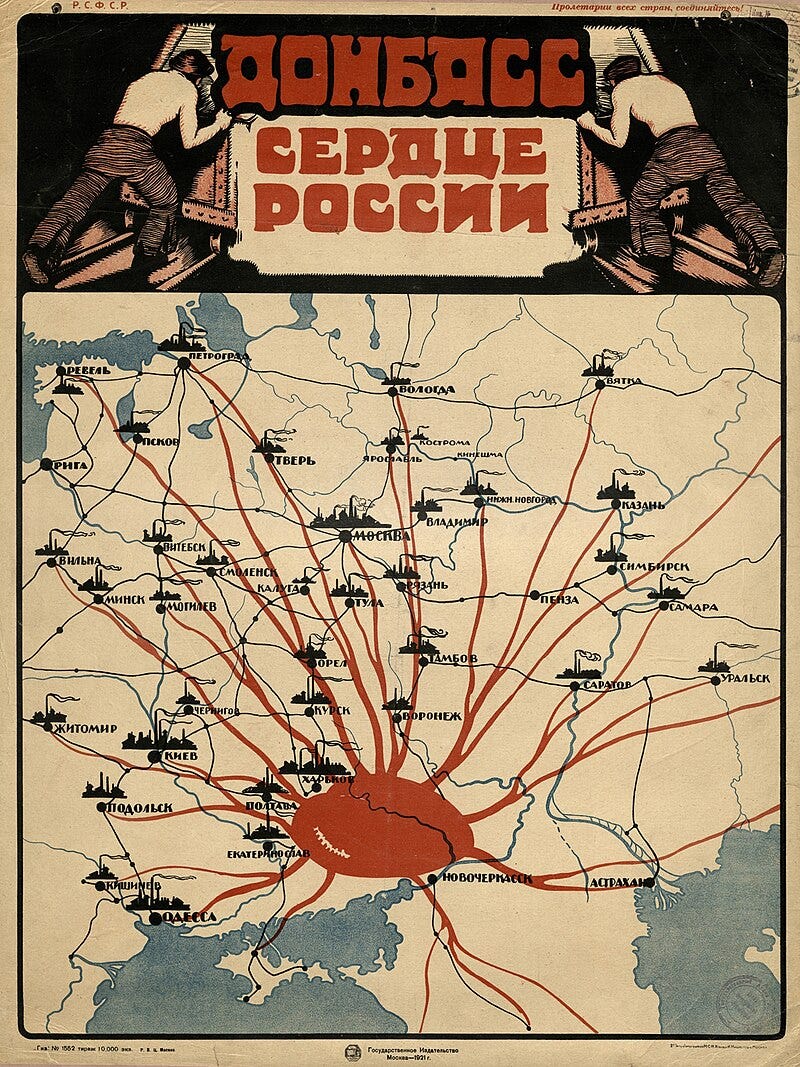
Iron & Manganese
Today, the most important iron ores are BIFs - banded iron formations. These formed mostly between 2,6-2,8 billion years ago, when volcanic activity enriched seawater with iron. Since the atmosphere didn’t contain oxygen at that time, and neither did the seawater, the iron was not oxidized and stayed in solution. When evolution came up with cyanobacteria, that changed dramatically: The cyanobacteria produced oxygen and this led to the precipitation of iron oxides on the shelves of the ancient continent, producing huge (and I mean really HUGE) iron ore provinces. Like around Kryvoy Rog, but also in the Great Lakes area, Northern Brazil, Western & Southern Africa and, most importantly, Western Australia. This stuff is practically the only iron ore of economic value today, although in earlier times, many other types of ores were used.
The manganese deposits are basically the same, but manganese oxidizes a bit later, so the BMF (banded manganese formations) form a bit further away.
Around Krivoy Rog, the landscape is characterized by iron mine. Like in the Donbas, industrialization started here in the late 19th century. The iron deposits are the fifth largest globally at around 6,5 bn t. The Ukrainian manganese reserves stand at 140 Mt, the world’s largest, but closely behind RSA with 120 Mt.
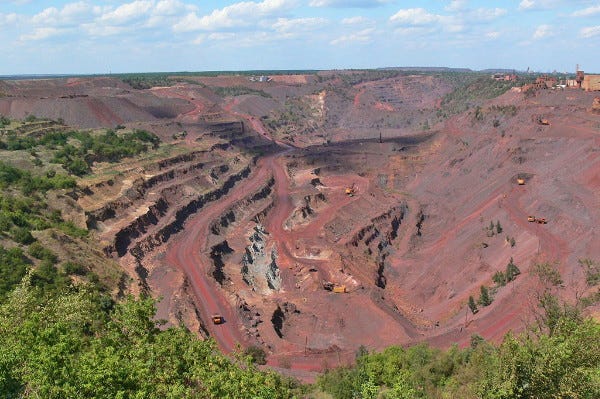
Other Metals
Other notable metals produced are aluminium, a bit of gallium & germanium (only a few percent of global production, like 98% comes from China) and titanium. There’s some gold but not much and lithium pegmatites exist as well, but as of now, both metals are not mined. As you can imagine, during the most recent lithium boom, Ukraine wasn’t attractive for western explorers. Since Europe has other lithium producers coming online, the strategic importance of the lithium in Ukraine appears very limited to me. Lithium isn’t rare.
More on ESG normy-conformy euro lithium here:
Europe's Critical Metals
In my previous article, I gave an overlook about the European mining, focussing only on producing metal mines. But of course, this is only one part of the story: There are many advanced development projects in Europe. In this article, I want to give you taste what’s going in that regard and prove the point that there is still lots of exploration potenti…
The industrial minerals sector (clays, etc.) is relatively big and should not be forgotten, same goes for some minor niche products. I remember helium is produced in Ukraine as well, that made the news two years ago.
Oil & Gas
On the potential side, oil and gas are important, but not much has been developed so far, most likely because of the civil war since 2014 and because Ukraine is and was corrupt as hell. The Donbas coal is known for being very rich in methane - making mining very dangerous - and the Donbas rift system stretches further NW into Belarus. Hence, the NE part of Ukraine hosts some potentially big natural gas deposits, maybe even oil.
In the SW, the pre-Carpathian basin around Lviv is known to host oil and gas. These oil fields played an important role in the early 20th century. Around Crimea in the Black Sea, some oil and gas was exploited and likely, there is potential to reactivate these platforms when peace is established (hopefully soon).
Agriculture
While I am certainly no expert here, I want to include it for the sake of completeness. Ukraine’s south (not so much the west and north, too many forests) is prime agricultural land and extremely important on a global scale. The reason for this - here comes the geology again - is the black soil in the area. This soil is made up of fine sediments transported there by the wind during the last ice age, called loess. The black colour comes from the high organic matter content formed by the slow decomposition of it under the steppe climate. This soil type is called Czernozem - a word derived from Russian meaning black soil. The same type of soil occurs in the Argentine Pampa, in the Midwest of the US and in some other places, even in Germany, in the Magdeburger Börde - the richest soil of the country.
Logically, Ukrainian grain exports play an important role on a global scale, feeding especially developing countries.
Interesting side story: Ukraine was home to the world’s only scandium mine during the Cold War. Only 15-20 t scandium oxide is produced today annually, and only as by-product from very few mines. It is mostly used for very bright lamps like in stadiums or construction sites. It also can be alloyed with aluminium (less than 1% Sc needed) to strongly increase the heat resistivity and hardness of aluminium. Since the density of aluminium is only 2,7 g/cm³, it is much lighter than titanium (4,5 g/cm³). What is that good for? Fighter jets! While normal planes can be made of aluminium, the metal is too soft for a fighter yet, so usually titanium is used. The Soviets, however, used their scandium to produce the Al-Sc alloy and build their Mig-29 with it. Due to the reduction of weight without sacrificing other properties, the Mig-29 had superior flying capabilities. Found that story interesting and wanted to share it.
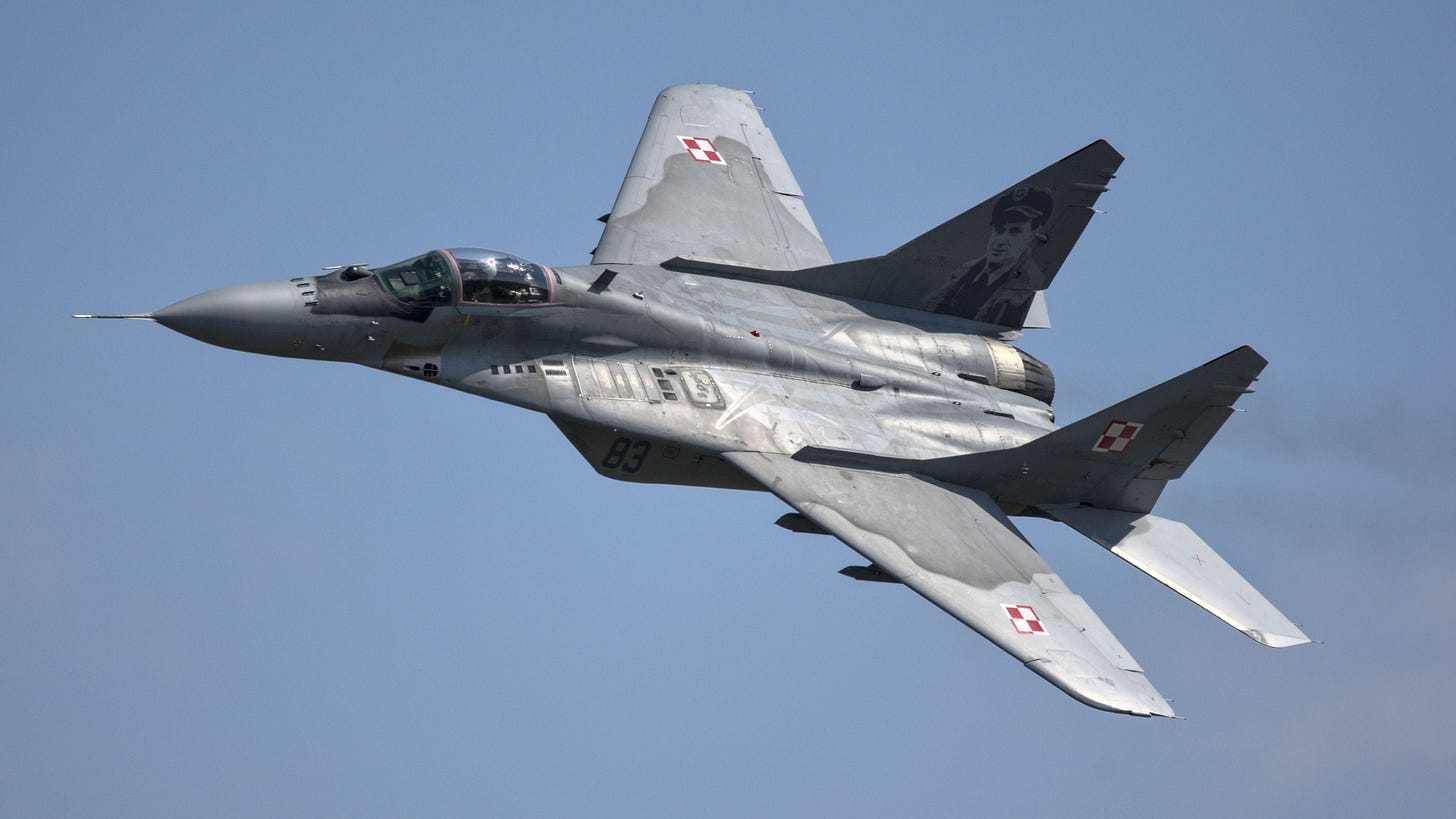
Strategic implications
Neither side wants Ukraine’s resource for the other. We could talk endlessly here about what caused the current war, but there are plenty of other authors doing that, and things become more obvious by the day. I just make it simple: Russia is winning and will take at least the commodity-rich and industrialized SE of pre-2014 Ukraine, like it or not. Western Ukraine is basically just forest and B-class farmland without major industrial centres, if Russia takes that or not, I have no clear opinion. It is among the poorest parts of Europe and, at least now, the population there - unlike in the east - is very hostile to Russia. It’ll either be a neutral rump state or a Russian protectorate, perhaps the Russians trick the Poles into taking Lwów back (using the Polish name here) to cause trouble within the West. But the Black Sea coast, Donbass, and most likely the Krivoy Rog area south of Kiev will become Russian (=what’s historically called Novorossiya after it was conquered from the Ottomans in the late 18th century by Catharina the Great). In short: All the good parts were mostly Russians live will be part of Russia. This is my expectation and base case.

This, of course, means that the EU/West looses access to the cheap coal and steel assets and Russia gains them. The titanium (a critical metal in the EU) likely is an issue as well, although it comes from an area ~100km west of Kiev. Since Russia is a very resource rich country, the gain of these assets is not a game changer for them, but surely will add to the Russian economy.
With the increasingly high losses of the Ukrainian military and increasingly nasty, cruel stuff happening (you’ve seen the videos of men dragged from the streets to be thrown to the front?) makes me think that the plan is now to kill as many Ukrainians in order to make Russia gain unpopulated territory. A similar tactic was used by the German Army in the Soviet Union: Verbrannte Erde/Burnt soil. From a military standpoint, the result of this war is already obvious; hence it is time to negotiate. While there are many reasons for this not happening (in a constructive way = with Russia at the table), the result is most importantly that more Ukrainian men dying or getting crippled and more women leaving the country. Therefore, I come to the conclusion that this is a deliberate tactic or at least a welcome side effect of the West to weaken Russia post victory. As Tom Luongo summarizes the cynic thinking of the Blinkens, Nulands, von der Leyens and so on: “What are 100,000 dead Slavs fighting over a swampland? A good start.” Whether those people actually see the reality (or care?) is another question.
The Russian perspective is rather to see this conflict as a civil war, meaning that the more people die, the less you have after the war is over. And the demographics in Russia aren’t better than in the West. It is a very, very tragic situation killing Ukraine as a country. The longer this goes on, the worse for Ukraine. Its supporters in the West should start to understand that.
With the loss of Ukrainian steel production and sanctions on Russian steel imports, the EU will need to find new sources for imports since local production doesn’t meet the demand. Outside of Poland, metallurgical coal isn’t produced anymore in the EU, it’s all imported from South Africa, Australia, Columbia, etc. The first one is also a major manganese supplier to the EU. So this causes some pain, and ironically, instead of opening coal mines again (Germany’s last mine closed only in 2018), they are dubbing down on hydrogen steel. I am highly sceptical whether it is possible to produce steel with hydrogen under economic conditions. Another way to deindustrialize Germany? Likely. It will also be interesting to see whether team “Fight Climate Change!” or team “Fight the evil Sov.. Russians!” will win in Brussels. I’d bet on the latter one. Might be interesting for the few EU met coal producers.
The natural gas fields of Ukraine perhaps were planned to supply the EU and make it more independent of Russian imports. Well, that’s definitely gone now. And this makes me wonder even more why the huge Greek gas fields aren’t getting developed. With new coal projects being practically impossible in Europe (and mind you, Europe has rich coal fields), the producing mines in the Donbas are certainly an interesting, if not strategic, asset. With Russia gaining control of the Donbas’ coal and Ukrainian gas fields, it cuts Europe further off its energy supply, just like they do in West Africa with the uranium.
Regarding Ukrainian lithium, while I think it is not really a big thing, I could very well imagine that some midwit EU-bureaucrats thought Ukraine will be their big battery. The assessments of these people and a those of sceptical geos like me usually don’t come to the same conclusions.
But I think the most important aspect here is the grain: Losing control of the grain export of Ukraine means less power over developing countries needing to import this grain to feed their populations. Russia+Ukraine produce a very large amount of exportable grain (17 and 10% in 2021) and Russia could further gain the power to significantly lower prices for friendly countries in the Middle East and Africa, raising living standards (=supporting the local government) there and putting pressure on Western influence. I think this is the most important aspect of Ukraine’s commodities because it further enhances Russia’s influence over the Global South. If we take the pre-war numbers, Russia could be the source of 25% of exported wheat. Second in the list is the EU with 16%.
I hope this shorter article could give you some insights. It is not as deep as I usually go with my research, I just wanted to share on a quick note what I figured out. And yet again, it turned out to be longer than expected. Upsie. If some of you know more about this topic, please let me know in the comments. I am also welcoming any other post-war perspective on the Ukraine, I merely presented here what I find most likely to happen to have a base case from with I can deduct potential outcomes.
Let’s just hope that this mess over there ends as soon as possible.
For further info, I can recommend this 20 min video from late 2022:
Some housekeeping: I’ll start a new job next week in the mineral exploration business, hence less time for this hobby here. I’ll try to keep writing articles of the usual length every ~two weeks like before, but don’t be disappointed if it lasts a bit longer.
See you next time and Спасибі/Спасибо for reading!



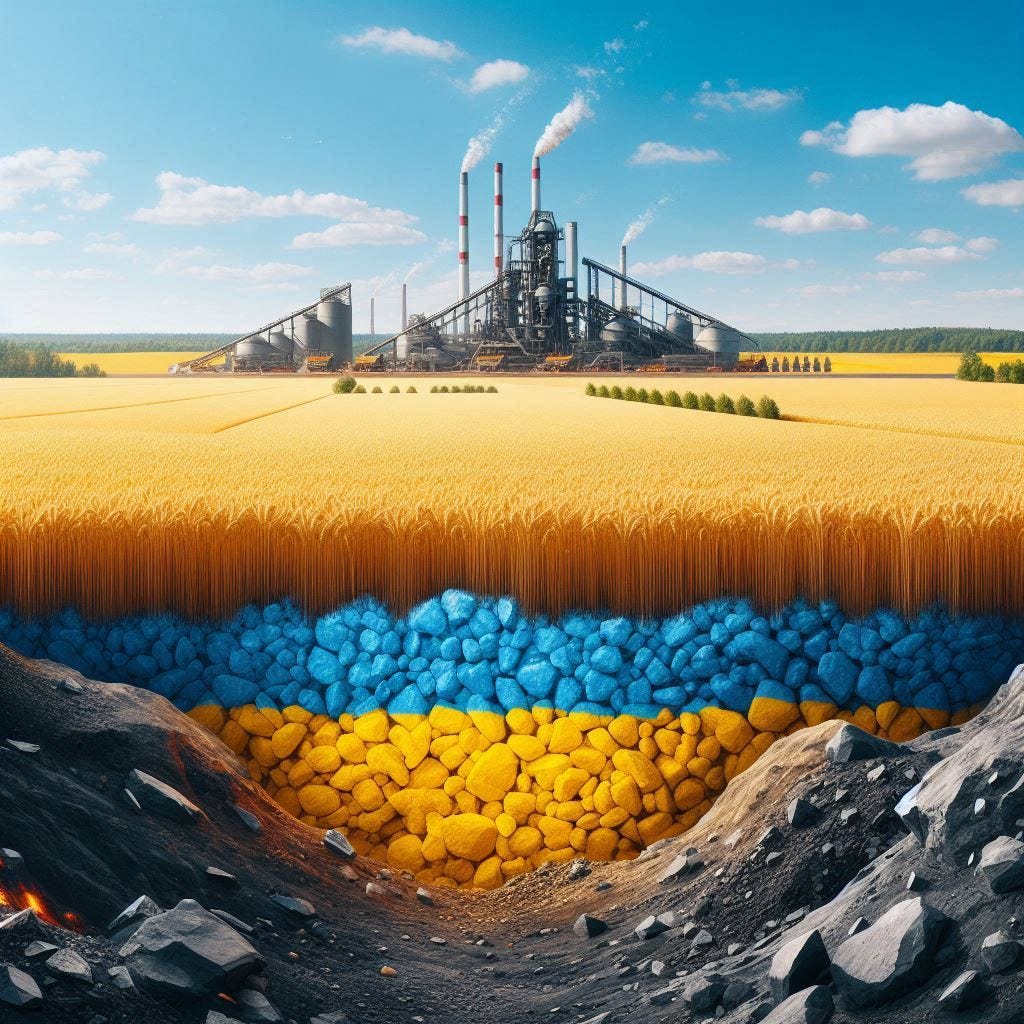


I recently a heard a story regarding the removal \transplantation of a village to enhance the production of a current coal mine in Germany.' Know anything about that? I also heard about garnet mining in the Vissytnia Oblast. On personal note interested in color and quality of garnet stones. Intriguing article for a non geologist and mining/resource investor.
Thanks very much for sharing this interesting and informative article.